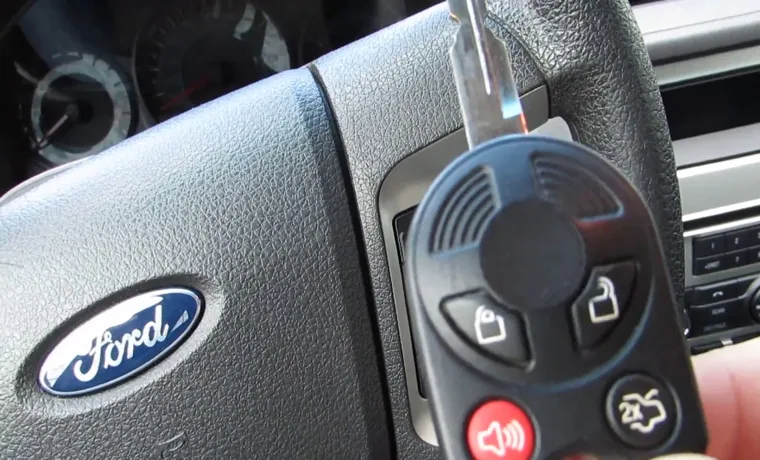Do you often experience problems with your tire pressure sensor? It can be frustrating to deal with the continuous alerts and warnings, but don’t worry, you’re not alone! Fortunately, resetting your tire pressure sensor is a relatively simple process that can be done yourself without having to take it to the dealer. In this step-by-step guide, we’ll walk you through the entire process of resetting your tire pressure sensor fault. We’ll cover everything, including what the tire pressure sensor actually does and why it’s important to maintain it, common issues that cause it to malfunction, tips on identifying when the sensor needs resetting, and finally, the technical steps you need to follow to reset the sensor yourself.
By the end of this guide, you’ll be equipped to quickly and efficiently address tire pressure sensor faults on your own, ensuring that your tire pressure sensor is functioning optimally. So, let’s get started!
Table of Contents
Introduction
If you ever get a tire pressure sensor fault in your vehicle, don’t worry, it’s not uncommon and can easily be resolved by resetting the system. The sensors in your tires monitor the pressure and send that data to the control module in your car. If the pressure is below or above the recommended level, it triggers a warning signal on your dashboard.
Sometimes, the sensors can malfunction and fail to provide accurate readings, leading to a fault message. To reset the system, first, make sure all your tires are properly inflated to the recommended pressure. Next, locate the reset button, either under the steering wheel or in the glove compartment, and press it until the light blinks.
After a few seconds, the light will stop flashing, indicating that the reset was successful. It’s a quick and easy fix that can save you a trip to the mechanic and ensure your tires are functioning correctly.
Understanding Tire Pressure Sensor Faults
Tire Pressure Sensor Faults If you are a driver, you have likely come across a tire pressure monitoring system (TPMS) warning light on your dashboard, indicating an issue with your car’s tire pressure. TPMS uses tire pressure sensors to monitor air pressure levels in tires, alerting drivers when they fall below the optimal range. However, these sensors can sometimes malfunction, causing inaccurate readings and warning signals.
This can be due to a range of issues, such as a dead battery in the sensor, damaged or faulty sensors, or even issues with the car’s computer system. Understanding what can cause TPMS faults is crucial for maintaining your car’s safety and avoiding unnecessary repair costs. In this article, we will delve deeper into TPMS faults and the best ways to address them.

Why Resetting Tire Pressure Sensor Faults is Important
If you own a car, you may have experienced the frustration of a tire pressure sensor fault that won’t go away. While it may be tempting to ignore these warning signals, resetting the sensor faults is crucial to ensuring that your vehicle is safe to drive. The tire pressure sensors are an essential component of your car’s safety system, and any malfunction could lead to serious accidents.
By resetting the sensor faults, you can avoid false warning signals and ensure that you get accurate readings of your tire pressure. So the next time your car’s tire pressure sensor goes off, take the time to reset the faults and ensure that you and your passengers stay safe on the road.
Checking Your Tires and Sensors
If you have a tire pressure sensor fault, the first thing you should do is check your tires to see if they are properly inflated. It’s important to use a tire pressure gauge to check the pressure of each tire and compare it to the manufacturer’s recommended PSI. If you find that your tires are underinflated, inflate them to the recommended level and drive your car for a short distance to allow the tire pressure monitoring system to reset itself.
If this doesn’t solve the sensor fault, you may need to manually reset the sensors. To do this, consult your vehicle’s owner manual to learn how to access the system’s reset menu. Once you’ve located the menu, follow the prompts to reset the sensors and clear the error codes.
Keep in mind that different makes and models may have different reset procedures, so it’s important to consult your owner’s manual for proper instructions. By taking a few simple steps, you can ensure that your tire pressure sensors are functioning properly and keeping you safe on the road.
Checking Tire Pressure
Checking your tire pressure on a regular basis is essential for both your safety and your vehicle’s performance. Underinflated tires can lead to poor gas mileage, premature wear and tear on your tires, and even dangerous blowouts. Luckily, checking your tire pressure is relatively simple.
First, find your vehicle’s recommended tire pressure in the owner’s manual or on the tire information placard located on the driver’s side door jamb. Then, use a tire pressure gauge to measure the pressure in each tire and add air as needed. Don’t forget to also check your tire pressure monitoring system, if equipped, for any alerts indicating low pressure.
By regularly checking your tire pressure and sensors, you can help ensure safe and efficient travels on the road.
Checking for Physical Damage to Sensor
Tire sensors are crucial in providing real-time information about your vehicle’s tire pressure and temperature. However, these sensors can be damaged over time due to various reasons, such as impact or corrosion. Therefore, it is essential to conduct regular physical inspections to check for any signs of damage to your tire sensors.
You can start by visually inspecting the sensors for scratches, dents, or any other form of visible damage. In case you notice any damage, you should replace the sensor immediately to prevent further damage. Additionally, you can take your vehicle to a professional mechanic who can perform more specialized tests on your sensors to ensure they are functioning correctly.
Remember, maintaining healthy sensors is critical in ensuring that your tires are always in good shape, making your driving experience safer and more comfortable.
Resetting the Tire Pressure Sensor
Have you ever seen a warning light on your dashboard that says “Tire Pressure Sensor Fault”? Don’t panic – it’s a pretty common issue and it’s easy to fix. Your car’s tire pressure sensor is designed to monitor your tire’s air pressure and alert you if one or more tires are underinflated. However, sometimes the sensor can become faulty and give you a false reading, which triggers the warning light.
To fix this issue, you’ll need to reset the tire pressure sensor. How to reset it can vary depending on the make and model of your vehicle. However, the process usually involves pressing a button on the dashboard or using a diagnostic tool to reset the sensor.
If you’re unsure how to do this, consult your car’s manual or take it to a mechanic. Remember, driving with underinflated tires can be dangerous, so it’s important to address any issues with the tire pressure sensor as soon as possible.
Consulting Your Vehicle’s Manual
If you want to know how to reset your vehicle’s tire pressure sensor, consulting the owner’s manual should be your first step. Your manual will provide specific instructions on how to reset the sensor, as well as any other tire maintenance tips you should be aware of. The process of resetting the sensor will vary depending on the make and model of your car, so it’s important to follow the instructions provided in the manual.
Some vehicles may require you to use a button to reset the sensor, while others may require you to perform a series of steps with the ignition key. By following the instructions provided in the manual, you can ensure that your tire pressure sensor is functioning properly, which will help keep you and your passengers safe on the road. Don’t be afraid to consult your manual if you’re unsure about how to reset your tire pressure sensor – it’s always better to be safe than sorry!
Using the Tire Pressure Monitoring System Reset Button
Resetting the tire pressure sensor is an essential task to ensure the proper functioning of your vehicle. To reset the Tire Pressure Monitoring System (TPMS), locate the TPMS reset button in your car. This button is usually located below the steering wheel, on the dashboard, or near the gear shift.
Once you find the button, turn on your car’s ignition, but do not start the engine. Press and hold the TPMS reset button until the TPMS light flashes twice, indicating that the system is resetting. Release the button, and the TPMS light will turn off, indicating that the reset process is complete.
Remember, resetting the tire pressure sensor is crucial to avoid potential accidents on the road, improve the lifespan of your tires, and reduce fuel costs. With a simple press of a button, you can keep your vehicle safe and efficient.
Tips for Troubleshooting and Maintenance
If you’ve been getting a tire pressure sensor fault on your dashboard, don’t panic. You may be able to reset it yourself without needing a mechanic. Here’s what you need to do: first, check your tires’ actual pressure using a tire gauge.
If any of them are below the recommended level, inflate them to the right psi. Then, turn on your car and locate the tire pressure monitor reset button, usually found on the dashboard or under the steering wheel. Press and hold the button until the light blinks a few times or turns off completely.
Once you release the button, the system should be reset. Keep in mind that this process may differ depending on your vehicle’s make and model, so always refer to your owner’s manual. With these simple steps, you can save yourself a trip to the mechanic and ensure your tires are operating safely.
Replacing Faulty Sensors
When it comes to faulty sensors, troubleshooting and maintenance play a critical role in ensuring smooth operations. If you encounter faulty sensors, it is crucial to check the wiring and connections to determine if they are the root cause of the issue. Additionally, faulty sensors may require calibration or replacement to restore proper function.
To prevent sensor failure, regular maintenance such as cleaning and inspection can help prolong their lifespan and prevent potential issues down the line. Remember, sensors play a vital role in overall system performance, and neglecting their maintenance can result in costly downtime. So, it is always better to stay ahead of the game and prioritize regular maintenance to keep everything running smoothly.
Regular Maintenance to Avoid Sensor Faults
Regular maintenance is essential to ensure your sensors work at their optimum level and avoid sensor faults. One of the important tips for troubleshooting and maintenance is to inspect the connectors and cables regularly. Check for any signs of wear and tear, corrosion, or loose connections and replace them immediately.
It is also essential to calibrate the sensors periodically to ensure their reliability and accuracy. Don’t forget to check the power supply to the sensors and ensure it is adequate and consistent. Additionally, make sure the sensors are installed correctly and that their environment is suitable for their operation.
By following these simple tips, you can avoid sensor faults and ensure your sensors perform their best. Remember, regular maintenance is the key to preventing costly repairs and replacements.
Conclusion
In conclusion, resetting a tire pressure sensor fault can be as easy as following a few simple steps. Just grab a tire pressure gauge, find the reset button, and press it until the light blinks. Voila! Your sensor is now reset and you can drive with peace of mind.
It’s like hitting the reset button on your computer, but instead of fixing a software glitch, you’re making sure your ride is running smoothly. So next time you see that pesky little light come on, don’t panic. Just give your sensor a reset and get back on the road with confidence.
“
FAQs
What does it mean when my tire pressure sensor fault light is on?
When the tire pressure sensor fault light illuminates on your vehicle’s dashboard, it means that one or more of your tires may be underinflated or there may be an issue with the sensor itself.
Can I reset my tire pressure sensor fault light myself?
Yes, you can reset the tire pressure sensor fault light yourself. The process varies depending on the make and model of your vehicle, so consult your owner’s manual for specific instructions.
How often should I check my tire pressure to prevent a sensor fault?
It’s recommended that you check your tire pressure at least once a month to prevent a sensor fault. Additionally, make sure to check your tire pressure whenever there’s a significant change in temperature or weather conditions.
What should I do if my tire pressure sensor fault light keeps coming on even after resetting it?
If your tire pressure sensor fault light keeps coming on even after resetting it, it may be an indication of a more serious issue with your tire pressure monitoring system. It’s recommended that you take your vehicle to a professional mechanic to diagnose and fix the problem.
How much does it cost to replace a faulty tire pressure sensor?
The cost of replacing a faulty tire pressure sensor varies depending on the make and model of your vehicle and the type of sensor needed. On average, you can expect to pay between $50 and $250 for a single sensor replacement.
Can a tire pressure sensor fault affect my vehicle’s performance?
Yes, a tire pressure sensor fault can affect your vehicle’s performance. Underinflated tires can lead to decreased fuel efficiency, poor handling, and increased wear and tear on your tires.
Is it safe to drive with a tire pressure sensor fault?
It’s generally safe to drive with a tire pressure sensor fault, but you should make sure to check your tire pressure regularly to ensure that your tires are properly inflated. Driving with underinflated tires can be dangerous and increase the risk of a blowout or accident.



